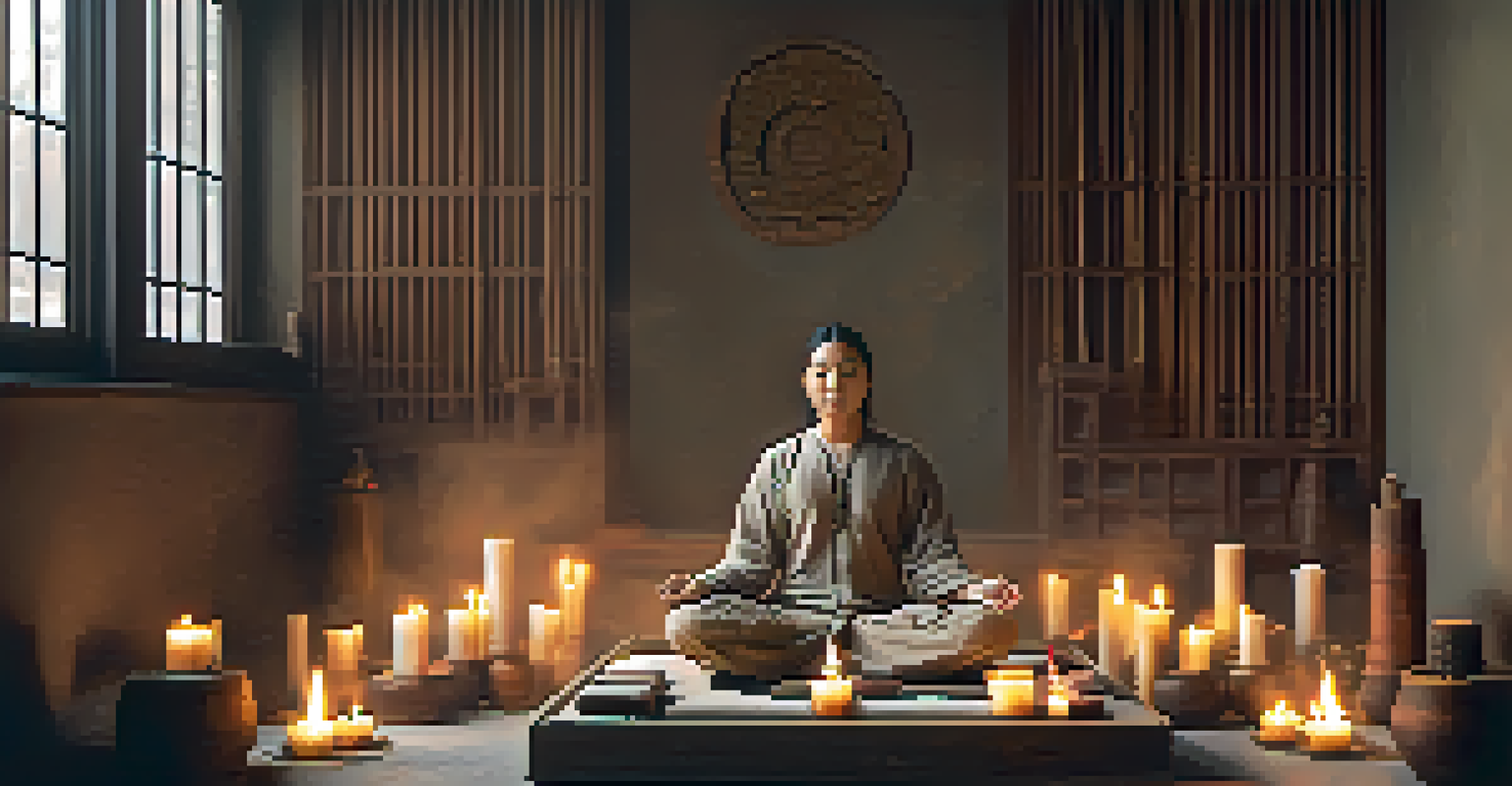The Therapeutic Benefits of Restorative Yoga for Mental Clarity

Understanding Restorative Yoga and Its Purpose
Restorative yoga is a gentle, calming practice that focuses on relaxation and rejuvenation. Unlike more vigorous styles, it encourages deep stretching and the use of props to support the body. This allows practitioners to hold poses for extended periods, facilitating a profound sense of peace.
Yoga is the journey of the self, through the self, to the self.
The primary goal of restorative yoga is to activate the parasympathetic nervous system, which helps reduce stress and anxiety. By fostering a state of deep relaxation, it creates an environment where the mind can unwind and clarify. This practice is especially beneficial for those who feel overwhelmed by daily life demands.
Many people find that just a few minutes in a restorative pose can lead to increased mental clarity. The stillness encourages introspection, making it easier to sift through thoughts and emotions. As a result, practitioners often leave their sessions feeling refreshed and clearer-headed.
How Restorative Yoga Affects the Brain
Engaging in restorative yoga has been shown to positively influence brain function. Through gentle stretching and mindfulness, it promotes neuroplasticity—the brain's ability to adapt and change. This adaptability can lead to improved cognitive function and emotional regulation.

Research indicates that restorative yoga can decrease levels of cortisol, the stress hormone, while boosting serotonin, the feel-good neurotransmitter. This hormonal balance not only enhances mood but also sharpens focus, making it easier to tackle tasks with clarity. It's like giving your brain a much-needed break.
Restorative Yoga Enhances Relaxation
This practice uses props and gentle stretching to promote deep relaxation and reduce stress.
Practicing restorative yoga regularly can create lasting changes in how your brain processes information and manages stress. Over time, individuals may experience increased resilience to anxiety and a greater capacity for concentration. It's a holistic approach that nurtures both mind and body.
The Role of Breath in Mental Clarity
Breath is a fundamental aspect of restorative yoga, serving as a bridge between the body and mind. Focusing on deep, intentional breathing helps calm the nervous system and anchor attention. This practice encourages mindfulness, which is key to enhancing mental clarity.
The mind is everything. What you think you become.
As practitioners learn to synchronize their breath with movement, they cultivate a sense of presence. This presence allows them to observe their thoughts without judgment, leading to insights and clarity. It's akin to clearing the fog from your mind, revealing a sharper focus.
By incorporating breathwork into restorative yoga, individuals can better manage stress and anxiety. The simple act of breathing deeply can create a ripple effect, promoting relaxation and clarity. In this way, breath becomes a powerful tool for mental wellness.
Restorative Yoga Poses for Mental Clarity
Certain restorative yoga poses are particularly effective for enhancing mental clarity. Poses like Child’s Pose, Legs-Up-The-Wall, and Supported Bridge require minimal effort while providing maximum relaxation. These postures help quiet the mind and release tension, allowing for greater mental focus.
For instance, Child’s Pose gently stretches the back and calms the nervous system, making it an excellent choice for moments of overwhelm. Similarly, Legs-Up-The-Wall is known for reducing anxiety and promoting blood flow to the brain. Each pose invites a sense of stillness that is conducive to mental clarity.
Breathwork Boosts Mental Clarity
Focusing on deep breathing during restorative yoga helps calm the mind and enhances mental focus.
Practicing these poses regularly can lead to a more balanced state of mind. As you become accustomed to the sensations and benefits, you may find it easier to access clarity in your daily life. Incorporating these restorative poses into your routine can be a game-changer for mental focus.
Creating a Restorative Yoga Routine
Building a restorative yoga routine can be a transformative experience for mental clarity. Start with a few simple poses and gradually increase your practice time. The key is to listen to your body and allow yourself the space to unwind without pressure.
Incorporate props like bolsters, blankets, and blocks to support your poses. These tools can enhance comfort and deepen relaxation, allowing you to hold each pose longer. A well-structured routine can help you develop a sense of rhythm and consistency, paving the way for clarity.
Consider setting aside specific times during the week to engage in restorative yoga. Whether it's a weekend ritual or a midweek reset, creating a routine can reinforce the mental clarity benefits. Over time, you’ll likely notice a shift in how you approach daily challenges.
Mindfulness and Meditation in Restorative Yoga
Mindfulness and meditation are integral components of restorative yoga, enhancing its therapeutic benefits. Practicing mindfulness during your yoga session allows you to stay present and aware of your thoughts and feelings. This awareness can lead to greater clarity and insight into your mental landscape.
Incorporating meditation techniques, such as focusing on breath or visualizations, can deepen your restorative experience. This combination fosters a tranquil state that encourages reflection and clarity. You may find that insights emerge more readily when the mind is calm and focused.
Long-Term Benefits for Well-Being
Regular practice of restorative yoga leads to improved emotional resilience and cognitive function over time.
By blending mindfulness and meditation with restorative yoga, you create a holistic approach to mental wellness. This practice not only nurtures relaxation but also cultivates a deeper understanding of oneself. As a result, you may feel more aligned and clear-headed in your everyday life.
The Long-Term Benefits of Restorative Yoga
The benefits of restorative yoga extend beyond immediate mental clarity. With regular practice, individuals may experience long-term improvements in emotional resilience and cognitive function. This makes it an excellent tool for managing stress and anxiety over time.
As your body becomes accustomed to relaxation, you may notice a greater ability to face challenges with a calm mind. This enhanced mental clarity can lead to more effective decision-making and problem-solving skills. It's like training your mind to remain steady in turbulent waters.

In the long run, restorative yoga can contribute to an overall sense of well-being. By prioritizing mental clarity through this practice, you may find yourself navigating life with greater ease and confidence. It's a journey of self-discovery that continues to unfold.